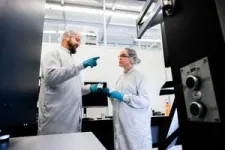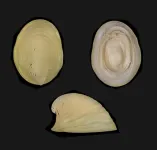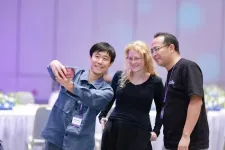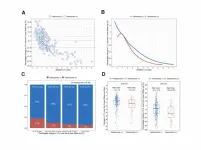(Press-News.org) Gold does not readily lend itself to being turned into long, thin threads. But researchers at Linköping University in Sweden have now managed to create gold nanowires and develop soft electrodes that can be connected to the nervous system. The electrodes are soft as nerves, stretchable and electrically conductive, and are projected to last for a long time in the body.
Some people have a “heart of gold”, so why not “nerves of gold”? In the future, it may be possible to use this precious metal in soft interfaces to connect electronics to the nervous system for medical purposes. Such technology could be used to alleviate conditions such as epilepsy, Parkinson’s disease, paralysis or chronic pain. However, creating an interface where electronics can meet the brain or other parts of the nervous system poses special challenges.
“The classical conductors used in electronics are metals, which are very hard and rigid. The mechanical properties of the nervous system are more reminiscent of soft jelly. In order to get an accurate signal transmission, we need to get very close to the nerve fibres in question, but as the body is constantly in motion, achieving close contact between something that is hard and something that is soft and fragile becomes a problem”, says Klas Tybrandt, professor of materials science at the Laboratory of Organic Electronics at Linköping University, who led the research.
Researchers therefore want to create electrodes that have good conductivity as well as mechanical properties similar to the softness of the body. In recent years, several studies have shown that soft electrodes do not damage the tissue as much as hard electrodes may do. In the current study, published in the journal Small, a group of researchers at Linköping University have developed gold nanowires – a thousand times thinner than a hair – and embedded them in an elastic material to create soft microelectrodes.
“We’ve succeeded in making a new, better nanomaterial from gold nanowires in combination with a very soft silicone rubber. Getting these to work together has resulted in a conductor that has high electrical conductivity, is very soft and made of biocompatible materials that function with the body,” says Klas Tybrandt.
Silicone rubber is used in medical implants, such as breast implants. The soft electrodes also include gold and platinum, metals that are common in medical devices for clinical use.
However, making long, narrow gold nanostructures is very difficult. This has so far been a major obstacle, but the researchers have now come up with a new way to manufacture gold nanowires. And they do it by using silver nanowires.
As silver has unique properties that make it a very good material to create the kind of nanowires that the researchers are after, it is used in some stretchable nanomaterials. The problem with silver is that it is chemically reactive. In the same way that silver cutlery will discolour over time when chemical reactions occur on the surface, silver in nanowires breaks down so that silver ions leak out. In a high enough concentration, silver ions can be toxic to us.
It was when Laura Seufert, a doctoral student in Klas Tybrandt’s research group, was working on finding a way to synthesize, or “grow”, gold nanowires that she came up with a new approach that opened up new possibilities. At first, it was difficult to control the shape of the nanowires. But then she discovered a way that resulted in very smooth wires. Instead of trying to grow gold nanowires from the beginning, she started with a thin nanowire made of pure silver.
“As it’s possible to make silver nanowires, we take advantage of this and use the silver nanowire as a kind of template on which we grow gold. The next step in the process is to remove the silver. Once that’s done, we have a material that has over 99 per cent gold in it. So it’s a bit of a trick to get around the problem of making long narrow gold nanostructures,” says Klas Tybrandt.
In collaboration with Professor Simon Farnebo at the Department of Biomedical and Clinical Sciences at Linköping University, the researchers behind the study have shown that the soft and elastic microelectrodes can stimulate a rat nerve as well capture signals from the nerve.
In applications where the soft electronics are to be embedded in the body, the material must last for a long time, preferably for life. The researchers have tested the stability of the new material and concluded that it will last for at least three years, which is better than many of the nanomaterials developed so far.
The research team is now working on refining the material and creating different types of electrodes that are even smaller and can come into closer contact with nerve cells.
The research has been funded with support from, among others, the Swedish Foundation for Strategic Research, the Swedish Research Council, the Knut and Alice Wallenberg Foundation and through the Swedish Government’s strategic research area in advanced functional materials, AFM, at Linköping University.
Article: Stretchable tissue-like gold nanowire composites with long-term stability for neural interfaces, Laura Seufert et al. Small, published online on June 30, 2024, DOI: https://doi.org/10.1002/smll.202402214
END
Soft gold enables connections between nerves and electronics
2024-08-06
ELSE PRESS RELEASES FROM THIS DATE:
The race to discover biodiversity: 11 new marine species and a new platform for rapid species description
2024-08-06
Accelerating global change continues to threaten Earth’s vast biodiversity, including in the oceans, which remain largely unexplored. To date, only a small fraction of an estimated two million total living marine species have been named and described. A major challenge is the time it takes to scientifically describe and publish a new species, which is a crucial step in studying and protecting these species. The current scientific and publishing landscape often results in decade-long delays (20-40 years) from the discovery of a new species to its official description. As an ...
18th Annual Q-Bio Conference: Global scholars explore new Frontiers in quantitative biology
2024-08-06
The 18th Q-Bio Conference on Quantitative Biology was held at the Guangming Yungu International Conference Center in Shenzhen from July 26 to 29, 2024. Organized by the Shenzhen Institute of Advanced Technology (SIAT) of the Chinese Academy of Sciences (CAS), the Shenzhen Institute of Synthetic Biology (iSynBio), and Peking University, the conference drew over 230 global researchers from countries including the U.S., U.K., France, India, Japan, Chile, and China.
Themed "Predictive Modeling and Quantitative Principles in Complex Biological Systems," the event explored future prospects in quantitative and synthetic biology. Under ...
Eating more fruits & vegetables to reduce dietary acid lowers blood pressure and improves kidney and heart health in patients with hypertension
2024-08-06
Philadelphia, August 6, 2024 – Doctors recommend making fruits and vegetables a foundational part of the treatment of patients with hypertension. Diets high in fruits and vegetables are found to lower blood pressure, reduce cardiovascular risk, and improve kidney health due to their base-producing effects. A new study in The American Journal of Medicine, published by Elsevier, details the findings from a five-year interventional randomized control trial.
Despite ongoing efforts to improve hypertension treatment and reduce its adverse outcomes with pharmacological strategies, hypertension-related chronic kidney disease and its cardiovascular mortality are increasing. Heart disease ...
Rising toll of serious injuries linked to expanded Mexico-US border wall crossing
2024-08-06
The expansion of the Mexico-US border wall crossing has been accompanied by a rising toll of serious injuries, with poor discharge care and a lack of appropriate interpreting facilities adding up to a “humanitarian and health crisis,” suggest researchers in the open access journal Trauma Surgery & Acute Care Open.
Thirty eight different nationalities and 21 languages other than Spanish were represented among those attempting to cross one segment of the wall in 2021 and 2022, say the researchers.
The Mexico-US border wall was extended by 50 miles and raised to a height of 30 feet in Southern California, construction ...
Interplay of sex, marital status, education, race linked to 18 year US lifespan gap
2024-08-06
The interplay of a quartet of sex, marital status, education, and race is linked to an 18 year lifespan gap for US citizens, and while no one factor is more influential than any of the others, the more of these influential factors a person has, the higher their risk of an earlier death, finds research published in the open access journal BMJ Open.
But a simple scoring system based on these characteristics can help overcome this complexity to identify those most at risk, say the researchers.
Individual risks and genetic factors explain part of the differences in health and death, but the evidence increasingly points to the role of social determinants—the ...
Arizona State University research site designated UNESCO World Heritage Site
2024-08-05
At the edge of the south coast of South Africa, Arizona State University professor Curtis Marean and his research teams have been teasing out the secrets of our earliest modern human ancestors in caves at Pinnacle Point for over 25 years.
In late July, the site was declared a UNESCO World Heritage Site, the Olympic gold medal of heritage, which is only given to sites of “outstanding universal value” to all of humanity.
In 1999, while conducting reconnaissance on the south coast ...
Association between osteoporosis and telomere shortening
2024-08-05
“We sought to identify an association between osteoporosis and LTL shortening in an independent prospective cohort.”
BUFFALO, NY- August 5, 2024 – A new research paper was published on the cover of Aging (listed by MEDLINE/PubMed as "Aging (Albany NY)" and "Aging-US" by Web of Science) Volume 16, Issue 14, entitled, “Association between osteoporosis and the rate of telomere shortening.”
A shorter leukocyte telomere length (LTL) is reported to be associated with age-related diseases, including osteoporosis. Many studies ...
DRI’s STEM education team receives EPA grant to support microplastics education for Nevada students and communities
2024-08-05
Reno, Nev. (August 5, 2024) – DRI’s STEM Education Team has received a grant from the Environmental Protection Agency (EPA) to support environmental education in Nevada’s schools.
The $100,000 grant will fund the production of additional educational kits known as Greenboxes that raise awareness and understanding of the prevalence and role of microplastics in the environment.
“DRI is honored to be awarded this EPA grant, and we are eager to continue our outreach to underserved rural and urban communities across Nevada,” said DRI STEM Education Program Manager Emily McDonald-Williams. “Middle school students ...
Sex bias in pain management at emergency departments new study reveals
2024-08-05
New study reveals a significant sex bias in pain management at emergency departments, showing that female patients are consistently less likely to receive pain medication prescriptions compared to male patients with similar complaints. This bias persists across different ages, pain levels, and physician sex, indicating a systemic issue. Female patients' pain scores are less frequently recorded, and they spend more time in the emergency department than male patients. The findings highlight the need for urgent policy interventions and training for healthcare ...
Child Mind Institute paper reveals next frontier in reproducible brain imaging for neuroscience discovery
2024-08-05
New York, NY (August 5, 2024) — The Child Mind Institute has released a paper detailing their pioneering study in the journal Nature Human Behaviour titled, "Moving Beyond Processing and Analysis-Related Variation in Resting State Functional Brain Imaging." The research identifies significant challenges in the reproducibility and standardization of functional magnetic resonance imaging (fMRI) used to understand brain function and behavior — and proposes concrete solutions to move the field towards results that translate into real world impact.
Along with a diverse team of international collaborators, ...







